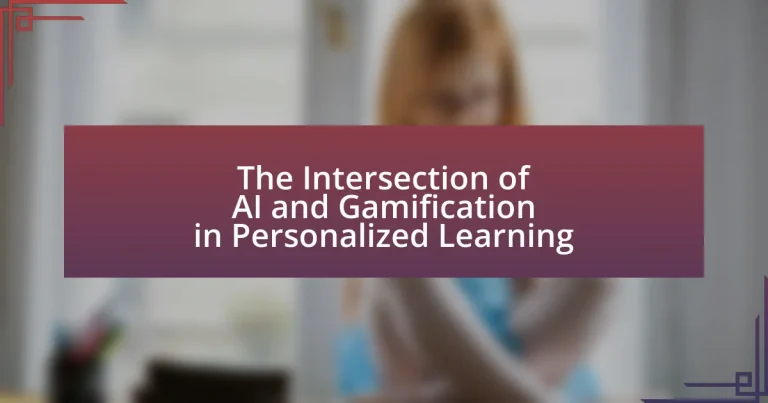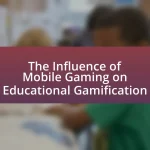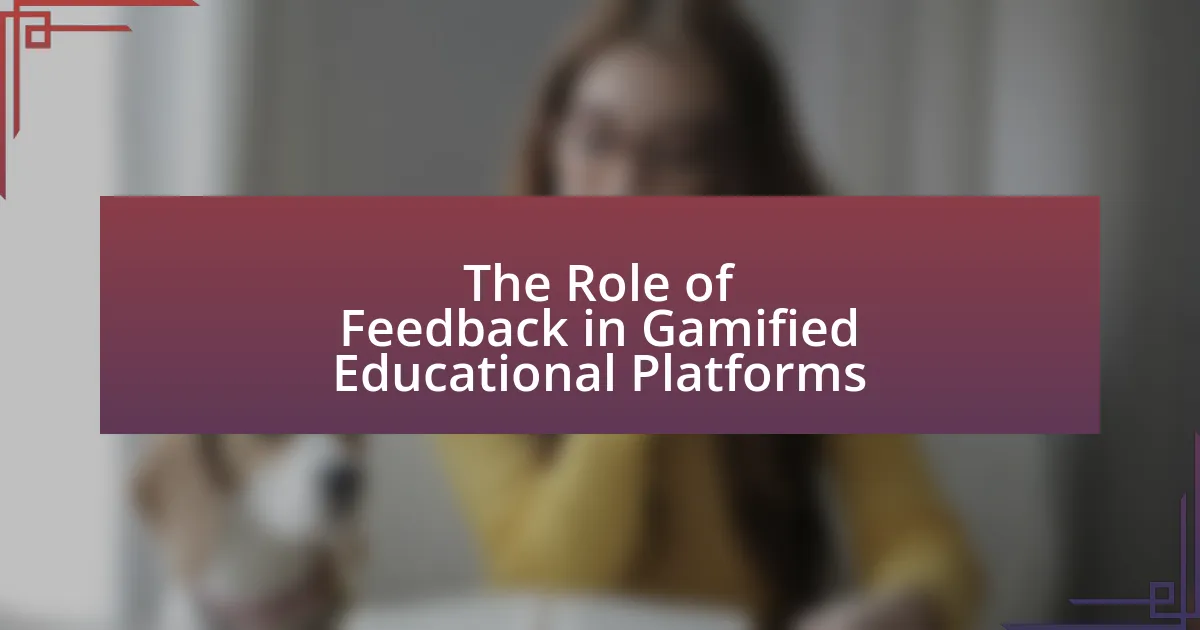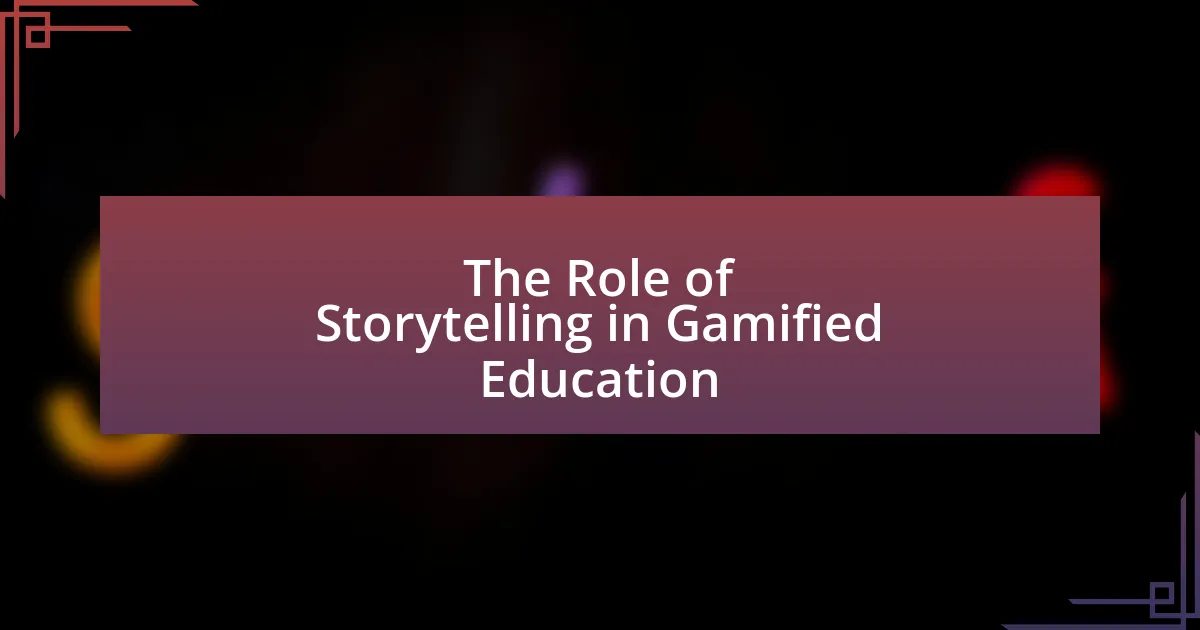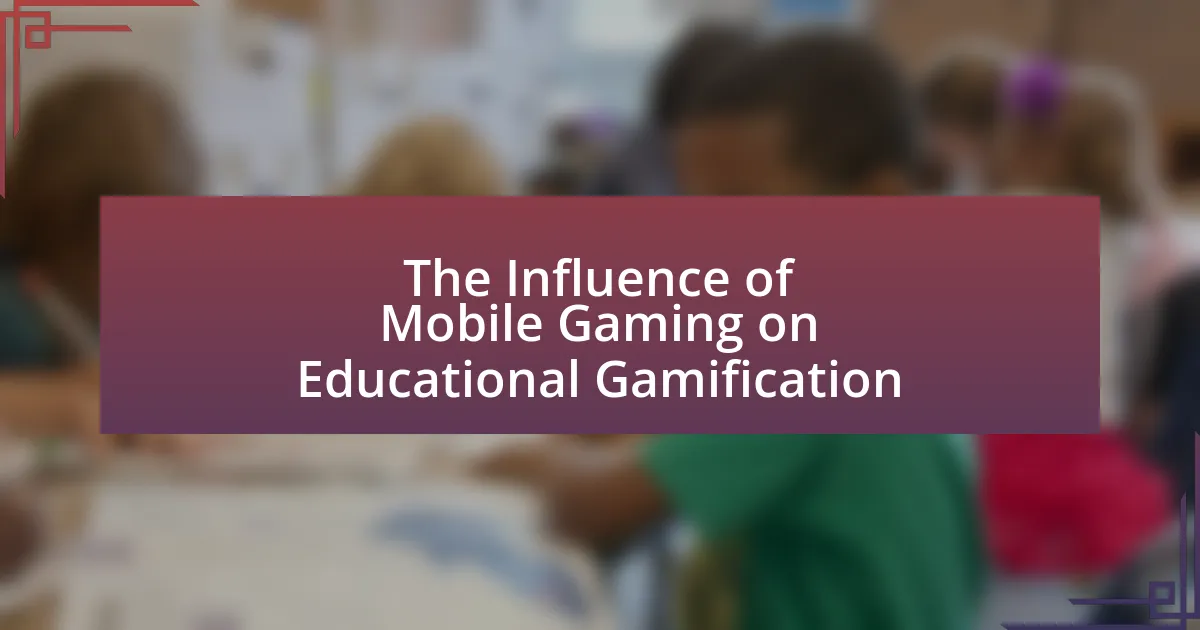The article explores the intersection of artificial intelligence (AI) and gamification in personalized learning, highlighting how these technologies enhance educational experiences tailored to individual learners. It discusses the distinct contributions of AI, which analyzes student data to create customized learning paths, and gamification, which incorporates game-like elements to boost motivation and engagement. Key components such as adaptive learning algorithms, user engagement mechanics, and data analytics are examined, along with the effectiveness of various gamification elements in educational settings. The article also addresses the challenges faced by traditional learning methods and outlines best practices for educators to implement AI and gamification effectively, ensuring inclusivity and accessibility while avoiding common pitfalls.
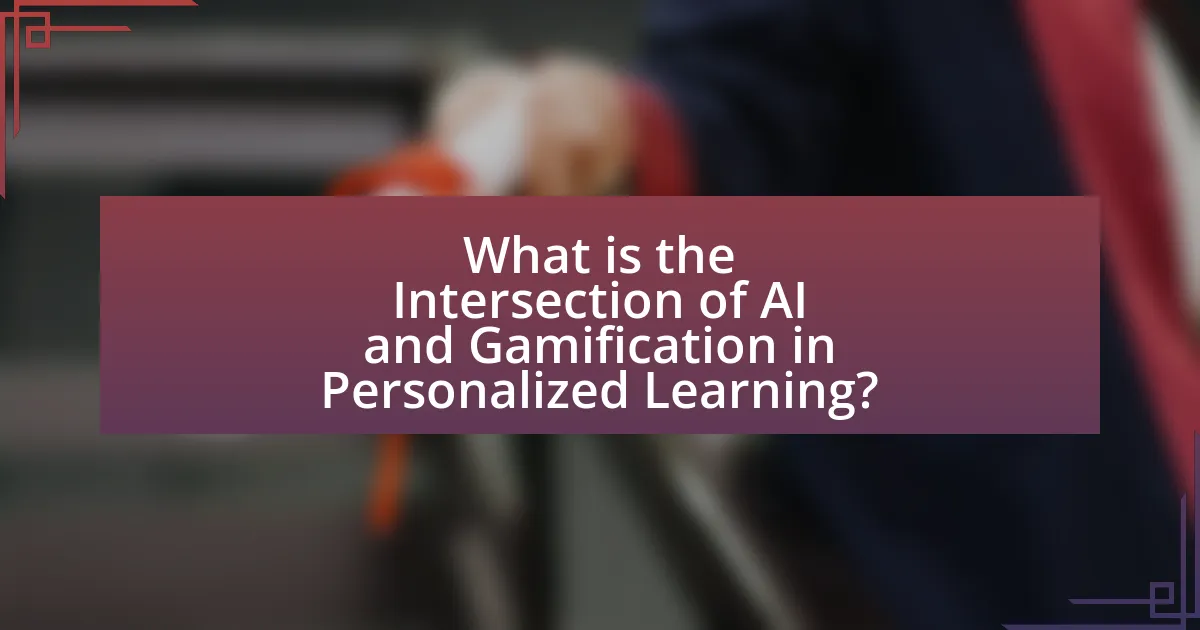
What is the Intersection of AI and Gamification in Personalized Learning?
The intersection of AI and gamification in personalized learning involves the integration of artificial intelligence technologies with game design elements to enhance educational experiences tailored to individual learners. AI analyzes student data to identify learning patterns and preferences, enabling the creation of customized learning paths. Gamification incorporates elements such as points, badges, and challenges to motivate and engage learners. Research indicates that this combination can improve student engagement and retention; for instance, a study published in the Journal of Educational Psychology found that gamified learning environments significantly increased student motivation and achievement.
How do AI and gamification individually contribute to personalized learning?
AI contributes to personalized learning by analyzing individual student data to tailor educational experiences, enhancing engagement and effectiveness. For instance, AI algorithms can assess a learner’s strengths and weaknesses, adapting content and pacing accordingly, which has been shown to improve learning outcomes significantly. In contrast, gamification enhances personalized learning by incorporating game-like elements, such as rewards and challenges, to motivate students and make learning more engaging. Research indicates that gamified learning environments can lead to increased student participation and retention of information, as they provide immediate feedback and a sense of achievement. Together, AI and gamification create a more customized and engaging educational experience, but each plays a distinct role in addressing individual learning needs.
What role does AI play in tailoring educational experiences?
AI plays a crucial role in tailoring educational experiences by analyzing individual learning patterns and preferences to create personalized learning pathways. Through data collection and machine learning algorithms, AI can assess a student’s strengths, weaknesses, and engagement levels, allowing for customized content delivery that meets their specific needs. For instance, platforms like DreamBox Learning utilize AI to adapt math lessons in real-time based on student performance, demonstrating the effectiveness of AI in enhancing personalized education.
How does gamification enhance engagement in learning environments?
Gamification enhances engagement in learning environments by incorporating game-like elements such as rewards, challenges, and competition, which motivate learners to participate actively. Research indicates that gamified learning experiences can increase student motivation and retention rates; for instance, a study published in the “Journal of Educational Psychology” found that students exposed to gamified elements scored 14% higher on assessments compared to those in traditional settings. This increase in engagement is attributed to the immediate feedback and sense of achievement that gamification provides, fostering a more interactive and enjoyable learning experience.
Why is the intersection of AI and gamification significant for education?
The intersection of AI and gamification is significant for education because it enhances personalized learning experiences, making them more engaging and effective. AI algorithms analyze individual learning patterns and preferences, allowing for tailored educational content that meets each student’s unique needs. For instance, a study by the Bill & Melinda Gates Foundation found that adaptive learning technologies, which often incorporate gamification elements, can improve student outcomes by 20% compared to traditional methods. This combination not only motivates learners through game-like elements but also provides real-time feedback, fostering a more interactive and responsive educational environment.
What challenges do traditional learning methods face that AI and gamification address?
Traditional learning methods face challenges such as lack of personalization, engagement issues, and limited feedback mechanisms, which AI and gamification effectively address. Traditional education often employs a one-size-fits-all approach, failing to cater to individual learning styles and paces; AI algorithms can analyze student data to provide tailored learning experiences. Engagement is another significant challenge, as conventional methods may not capture students’ interest; gamification introduces game-like elements that enhance motivation and participation. Additionally, traditional assessments often provide delayed feedback, whereas AI can offer real-time insights into student performance, allowing for immediate adjustments in learning strategies. These advancements demonstrate how AI and gamification can transform educational experiences by overcoming the limitations of traditional methods.
How can the combination of AI and gamification improve learning outcomes?
The combination of AI and gamification can significantly improve learning outcomes by personalizing the educational experience and enhancing engagement. AI algorithms analyze individual learning patterns and preferences, allowing for tailored content delivery that meets each learner’s unique needs. For instance, a study by the University of Michigan found that personalized learning environments, enhanced by AI, can lead to a 30% increase in student performance compared to traditional methods. Gamification elements, such as rewards and challenges, further motivate learners by making the educational process more interactive and enjoyable. This dual approach not only fosters deeper understanding but also encourages persistence in learning, ultimately leading to better retention of knowledge and improved academic results.
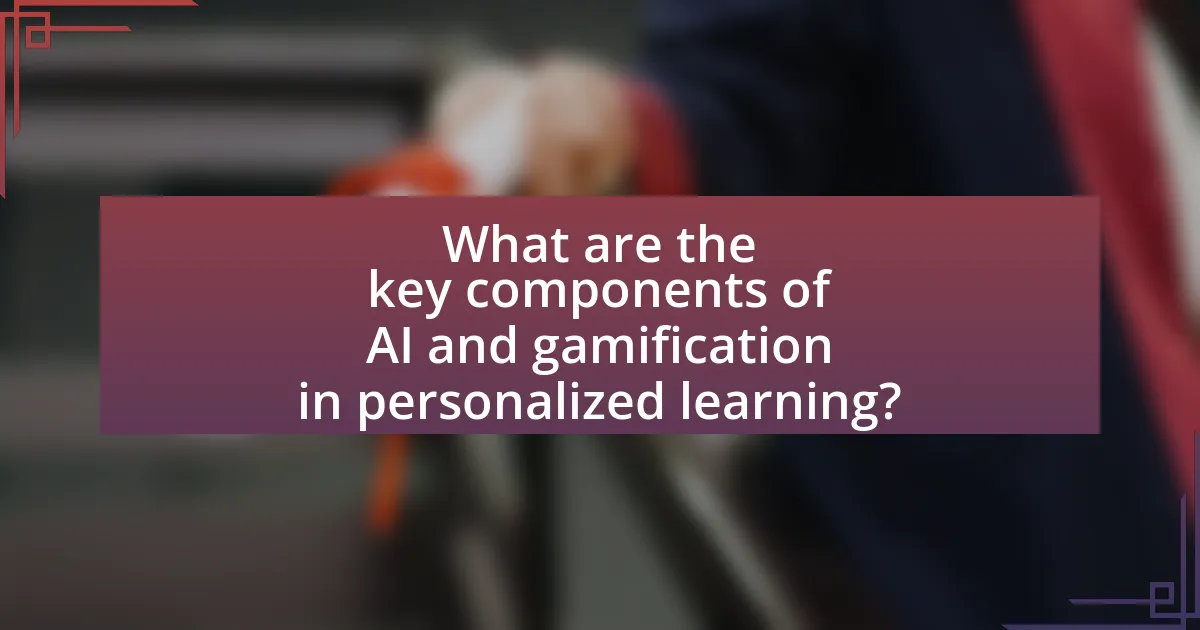
What are the key components of AI and gamification in personalized learning?
The key components of AI and gamification in personalized learning are adaptive learning algorithms, user engagement mechanics, and data analytics. Adaptive learning algorithms utilize AI to tailor educational content to individual learner needs, adjusting difficulty and pacing based on performance metrics. User engagement mechanics, derived from gamification principles, incorporate elements such as rewards, challenges, and progress tracking to motivate learners. Data analytics plays a crucial role by providing insights into learner behavior and outcomes, enabling continuous improvement of the learning experience. These components work synergistically to enhance personalized learning, making it more effective and engaging for students.
What technologies underpin AI in personalized learning?
AI in personalized learning is primarily underpinned by machine learning, natural language processing, and data analytics technologies. Machine learning algorithms analyze student data to identify learning patterns and preferences, enabling tailored educational experiences. Natural language processing facilitates interactive learning environments by allowing AI systems to understand and respond to student inquiries in real-time. Data analytics provides insights into student performance and engagement, helping educators refine instructional strategies. These technologies collectively enhance the effectiveness of personalized learning by adapting content and pacing to meet individual learner needs.
How do machine learning algorithms adapt to individual learning styles?
Machine learning algorithms adapt to individual learning styles by analyzing user interactions and preferences to tailor educational content. These algorithms utilize data from user behavior, such as response times, engagement levels, and content preferences, to identify patterns that correspond to different learning styles, such as visual, auditory, or kinesthetic. For instance, a study by K. M. K. Alharbi and A. A. Alzahrani in “Personalized Learning Using Machine Learning Techniques” (2020) demonstrates how adaptive learning systems can modify instructional strategies based on real-time feedback, enhancing the learning experience for each individual. This adaptability is crucial in personalized learning environments, allowing for more effective educational outcomes.
What data is essential for AI to function effectively in education?
AI in education requires several essential data types to function effectively, including student performance data, learning preferences, engagement metrics, and demographic information. Student performance data, such as grades and assessment scores, enables AI to tailor learning experiences to individual needs. Learning preferences, gathered through surveys or interaction patterns, help AI systems recommend personalized content. Engagement metrics, like time spent on tasks and participation rates, inform AI about student motivation and areas needing improvement. Demographic information, including age and background, allows for contextualized learning experiences. These data types collectively enhance AI’s ability to create personalized learning environments, as evidenced by studies showing that tailored educational interventions improve student outcomes significantly.
What elements of gamification are most effective in educational settings?
The most effective elements of gamification in educational settings include points, badges, leaderboards, and narrative context. Points provide immediate feedback and reward progress, while badges serve as recognition for achievements, motivating students to reach specific goals. Leaderboards foster a sense of competition and community among learners, encouraging engagement and participation. Additionally, narrative context enhances the learning experience by making content relatable and immersive, which can increase retention and interest. Research by Hamari, Koivisto, and Sarsa (2014) in “Gamification: A systematic literature review” indicates that these elements significantly enhance motivation and learning outcomes in educational environments.
How do game mechanics influence student motivation and participation?
Game mechanics significantly enhance student motivation and participation by creating engaging and interactive learning environments. These mechanics, such as points, levels, and rewards, provide immediate feedback and a sense of achievement, which are crucial for maintaining student interest. Research indicates that incorporating game elements can lead to a 50% increase in student engagement and motivation levels, as evidenced by studies conducted by the University of Colorado, which found that gamified learning experiences resulted in higher retention rates and improved academic performance. By leveraging these mechanics, educators can foster a more dynamic and participatory classroom atmosphere, ultimately leading to better educational outcomes.
What types of rewards and feedback are most beneficial in gamified learning?
In gamified learning, intrinsic rewards and timely feedback are the most beneficial types. Intrinsic rewards, such as a sense of achievement and personal growth, motivate learners by fostering engagement and satisfaction. Timely feedback, which provides immediate insights into performance, helps learners understand their progress and areas for improvement. Research indicates that intrinsic motivation significantly enhances learning outcomes, as evidenced by studies showing that learners who experience intrinsic rewards are more likely to persist in challenging tasks (Deci & Ryan, 2000). Additionally, timely feedback has been shown to improve retention and application of knowledge, as it allows learners to adjust their strategies in real-time (Hattie & Timperley, 2007).
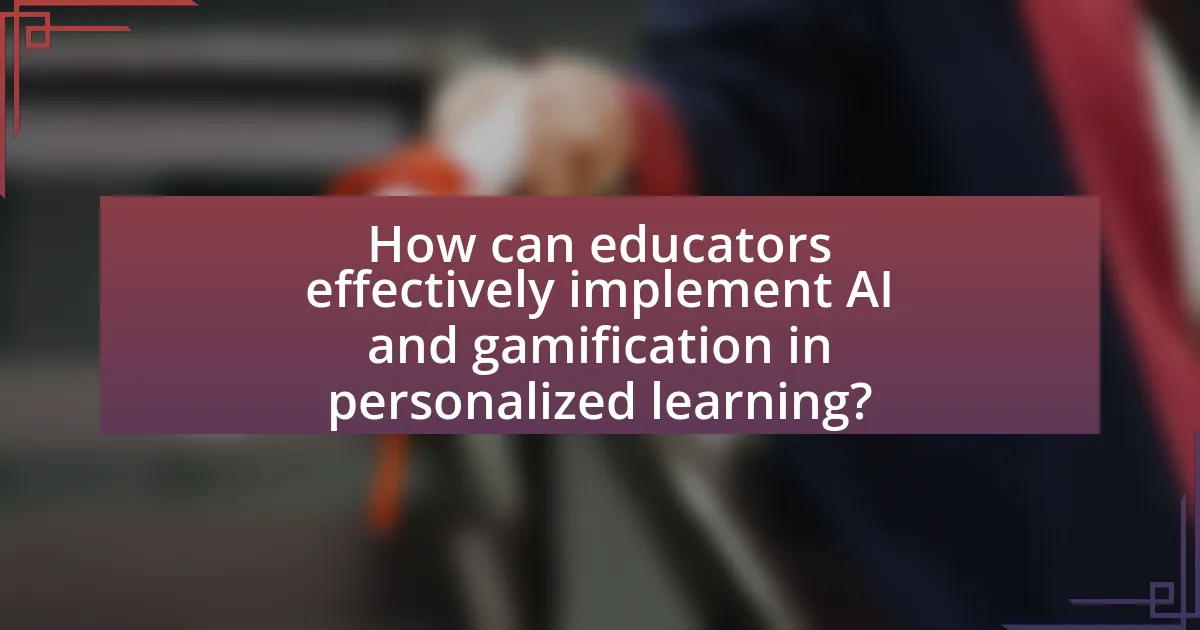
How can educators effectively implement AI and gamification in personalized learning?
Educators can effectively implement AI and gamification in personalized learning by integrating adaptive learning technologies that tailor educational experiences to individual student needs while incorporating game-based elements to enhance engagement. Adaptive learning platforms, such as DreamBox and Smart Sparrow, utilize AI algorithms to analyze student performance and adjust content accordingly, ensuring that learners receive customized pathways that match their skill levels. Simultaneously, gamification techniques, like point systems, badges, and leaderboards, motivate students by providing immediate feedback and rewards for progress, which has been shown to increase student engagement and retention rates. Research indicates that gamified learning environments can lead to a 34% increase in student engagement, as reported in a study by Hamari, Koivisto, and Sarsa (2014) in the Journal of Computer Science. By combining these approaches, educators can create a dynamic and responsive learning environment that fosters both academic achievement and student motivation.
What strategies can educators use to integrate AI and gamification?
Educators can integrate AI and gamification by utilizing adaptive learning platforms that personalize educational experiences based on individual student performance. These platforms leverage AI algorithms to assess student data and adjust the difficulty and type of gamified content accordingly, ensuring that learners remain engaged and challenged. For instance, research by the International Society for Technology in Education highlights that adaptive learning technologies can improve student outcomes by tailoring educational content to meet diverse learning needs. Additionally, educators can implement AI-driven analytics to track student progress in gamified environments, allowing for timely interventions and support. This strategic combination enhances motivation and fosters a more personalized learning journey.
How can teachers assess the effectiveness of AI-driven gamified learning?
Teachers can assess the effectiveness of AI-driven gamified learning by analyzing student engagement metrics, academic performance data, and feedback from learners. Engagement metrics, such as time spent on tasks and completion rates, provide insights into how well students interact with the gamified elements. Academic performance data, including test scores and assignment grades, can indicate whether the gamified approach enhances learning outcomes. Additionally, collecting qualitative feedback through surveys or interviews helps teachers understand students’ perceptions and experiences, allowing for adjustments to improve the learning process. Research shows that gamification can lead to increased motivation and improved learning outcomes, as evidenced by a study published in the Journal of Educational Psychology, which found that students in gamified environments demonstrated higher levels of engagement and achievement compared to traditional learning settings.
What tools and platforms are available for implementing these technologies?
Tools and platforms available for implementing AI and gamification in personalized learning include platforms like Kahoot!, Classcraft, and Edmodo. Kahoot! allows educators to create engaging quizzes that incorporate game mechanics, enhancing student participation. Classcraft integrates role-playing elements into the classroom, promoting collaboration and motivation among students. Edmodo serves as a social learning platform that combines educational resources with gamified elements, facilitating personalized learning experiences. These platforms leverage technology to create interactive and adaptive learning environments, supported by research indicating that gamification can improve student engagement and learning outcomes.
What best practices should educators follow when using AI and gamification?
Educators should prioritize student engagement, data privacy, and adaptive learning when using AI and gamification. Engaging students through interactive and immersive experiences enhances motivation and retention, as evidenced by studies showing that gamified learning environments can increase student participation by up to 50%. Additionally, maintaining data privacy is crucial; educators must ensure compliance with regulations like FERPA and GDPR to protect student information. Finally, utilizing AI to adapt learning experiences to individual student needs fosters personalized learning, which has been shown to improve academic outcomes by tailoring content to each learner’s pace and style.
How can educators ensure inclusivity and accessibility in gamified learning environments?
Educators can ensure inclusivity and accessibility in gamified learning environments by implementing universal design principles that accommodate diverse learning needs. This includes providing multiple means of engagement, representation, and action, which allows all students to participate effectively. For instance, incorporating adjustable difficulty levels in games can cater to varying skill sets, while offering content in multiple formats (text, audio, visual) ensures that learners with different preferences and abilities can access the material. Research indicates that applying these principles can enhance learning outcomes for students with disabilities, as evidenced by a study published in the “Journal of Educational Psychology,” which found that inclusive practices significantly improved engagement and achievement among diverse learners.
What common pitfalls should educators avoid when integrating AI and gamification?
Educators should avoid the pitfall of over-reliance on technology when integrating AI and gamification. This can lead to a lack of meaningful engagement and critical thinking among students, as they may become overly dependent on automated systems for learning. Research indicates that effective learning requires a balance between technology and traditional teaching methods, ensuring that educators remain facilitators of knowledge rather than mere overseers of technology. Additionally, educators should be cautious of implementing gamification without clear educational objectives, as this can result in superficial engagement rather than deep learning. Studies show that gamification strategies aligned with specific learning outcomes enhance student motivation and achievement, while poorly designed gamification can lead to frustration and disengagement.
